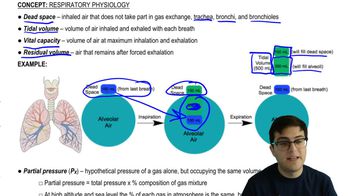Table of contents
- 1. Introduction to Biology2h 42m
- 2. Chemistry3h 40m
- 3. Water1h 26m
- 4. Biomolecules2h 23m
- 5. Cell Components2h 26m
- 6. The Membrane2h 31m
- 7. Energy and Metabolism2h 0m
- 8. Respiration2h 40m
- 9. Photosynthesis2h 49m
- 10. Cell Signaling59m
- 11. Cell Division2h 47m
- 12. Meiosis2h 0m
- 13. Mendelian Genetics4h 44m
- Introduction to Mendel's Experiments7m
- Genotype vs. Phenotype17m
- Punnett Squares13m
- Mendel's Experiments26m
- Mendel's Laws18m
- Monohybrid Crosses19m
- Test Crosses14m
- Dihybrid Crosses20m
- Punnett Square Probability26m
- Incomplete Dominance vs. Codominance20m
- Epistasis7m
- Non-Mendelian Genetics12m
- Pedigrees6m
- Autosomal Inheritance21m
- Sex-Linked Inheritance43m
- X-Inactivation9m
- 14. DNA Synthesis2h 27m
- 15. Gene Expression3h 20m
- 16. Regulation of Expression3h 31m
- Introduction to Regulation of Gene Expression13m
- Prokaryotic Gene Regulation via Operons27m
- The Lac Operon21m
- Glucose's Impact on Lac Operon25m
- The Trp Operon20m
- Review of the Lac Operon & Trp Operon11m
- Introduction to Eukaryotic Gene Regulation9m
- Eukaryotic Chromatin Modifications16m
- Eukaryotic Transcriptional Control22m
- Eukaryotic Post-Transcriptional Regulation28m
- Eukaryotic Post-Translational Regulation13m
- 17. Viruses37m
- 18. Biotechnology2h 58m
- 19. Genomics17m
- 20. Development1h 5m
- 21. Evolution3h 1m
- 22. Evolution of Populations3h 52m
- 23. Speciation1h 37m
- 24. History of Life on Earth2h 6m
- 25. Phylogeny2h 31m
- 26. Prokaryotes4h 59m
- 27. Protists1h 12m
- 28. Plants1h 22m
- 29. Fungi36m
- 30. Overview of Animals34m
- 31. Invertebrates1h 2m
- 32. Vertebrates50m
- 33. Plant Anatomy1h 3m
- 34. Vascular Plant Transport1h 2m
- 35. Soil37m
- 36. Plant Reproduction47m
- 37. Plant Sensation and Response1h 9m
- 38. Animal Form and Function1h 19m
- 39. Digestive System1h 10m
- 40. Circulatory System1h 57m
- 41. Immune System1h 12m
- 42. Osmoregulation and Excretion50m
- 43. Endocrine System1h 4m
- 44. Animal Reproduction1h 2m
- 45. Nervous System1h 55m
- 46. Sensory Systems46m
- 47. Muscle Systems23m
- 48. Ecology3h 11m
- Introduction to Ecology20m
- Biogeography14m
- Earth's Climate Patterns50m
- Introduction to Terrestrial Biomes10m
- Terrestrial Biomes: Near Equator13m
- Terrestrial Biomes: Temperate Regions10m
- Terrestrial Biomes: Northern Regions15m
- Introduction to Aquatic Biomes27m
- Freshwater Aquatic Biomes14m
- Marine Aquatic Biomes13m
- 49. Animal Behavior28m
- 50. Population Ecology3h 41m
- Introduction to Population Ecology28m
- Population Sampling Methods23m
- Life History12m
- Population Demography17m
- Factors Limiting Population Growth14m
- Introduction to Population Growth Models22m
- Linear Population Growth6m
- Exponential Population Growth29m
- Logistic Population Growth32m
- r/K Selection10m
- The Human Population22m
- 51. Community Ecology2h 46m
- Introduction to Community Ecology2m
- Introduction to Community Interactions9m
- Community Interactions: Competition (-/-)38m
- Community Interactions: Exploitation (+/-)23m
- Community Interactions: Mutualism (+/+) & Commensalism (+/0)9m
- Community Structure35m
- Community Dynamics26m
- Geographic Impact on Communities21m
- 52. Ecosystems2h 36m
- 53. Conservation Biology24m
37. Plant Sensation and Response
Tropisms and Hormones
Problem 12b`
Textbook Question
Leaflets of Mimosa pudica (common names: sensitive plant, touch-me-not) have a remarkable ability to close up in response to being touched or physically moved.
How fast can the leaflets close?
How does this occur?
And more importantly, what benefit could this unusual response provide to the plant?
Which of the following terms best describes the leaflet movement?
a. Thigmonastic movements
b. Thigmotropism
c. Thigmomorphogenesis
d. Apical dominance
 Verified step by step guidance
Verified step by step guidance1
Understand the terms: Each option describes a different type of plant response to stimuli. 'Thigmonastic movements' are rapid movements in response to touch, 'thigmotropism' is growth in response to touch, 'thigmomorphogenesis' is a change in growth pattern due to mechanical stress, and 'apical dominance' is the suppression of lateral bud growth by the apical bud.
Identify the type of movement: Mimosa pudica leaflets close rapidly when touched, indicating a quick, non-directional response to a stimulus.
Match the movement to the correct term: Since the movement is rapid and not related to growth direction, it aligns with 'thigmonastic movements'.
Consider the mechanism: The closing of leaflets is due to changes in turgor pressure within the cells at the base of the leaflets, causing them to fold.
Evaluate the benefit: This response may protect the plant from herbivores or physical damage by making the leaves less accessible or less appealing.
 Verified video answer for a similar problem:
Verified video answer for a similar problem:This video solution was recommended by our tutors as helpful for the problem above
Video duration:
2mPlay a video:
Was this helpful?
Key Concepts
Here are the essential concepts you must grasp in order to answer the question correctly.
Thigmonastic Movements
Thigmonastic movements are non-directional responses to touch or physical stimuli, where the movement is independent of the direction of the stimulus. In Mimosa pudica, the rapid closure of leaflets upon touch is a classic example of thigmonastic movement, which is a defense mechanism to deter herbivores or prevent damage.
Recommended video:
Guided course

Air Movement and Partial Pressure
Plant Defense Mechanisms
Plants have evolved various defense mechanisms to protect themselves from herbivores and environmental stress. The rapid closure of Mimosa pudica's leaflets can deter herbivores by making the plant appear less appealing or by startling them, thus reducing the likelihood of being eaten or damaged.
Recommended video:
Guided course

Pathogen Defenses
Mechanism of Leaflet Closure
The closure of Mimosa pudica's leaflets is facilitated by changes in turgor pressure within the pulvini, specialized cells at the base of the leaflets. When stimulated, these cells lose water rapidly, causing the leaflets to fold. This process is reversible, allowing the plant to reopen its leaves once the stimulus is removed.
Recommended video:
Guided course

Prey Defense Mechanisms
Related Videos
Related Practice























